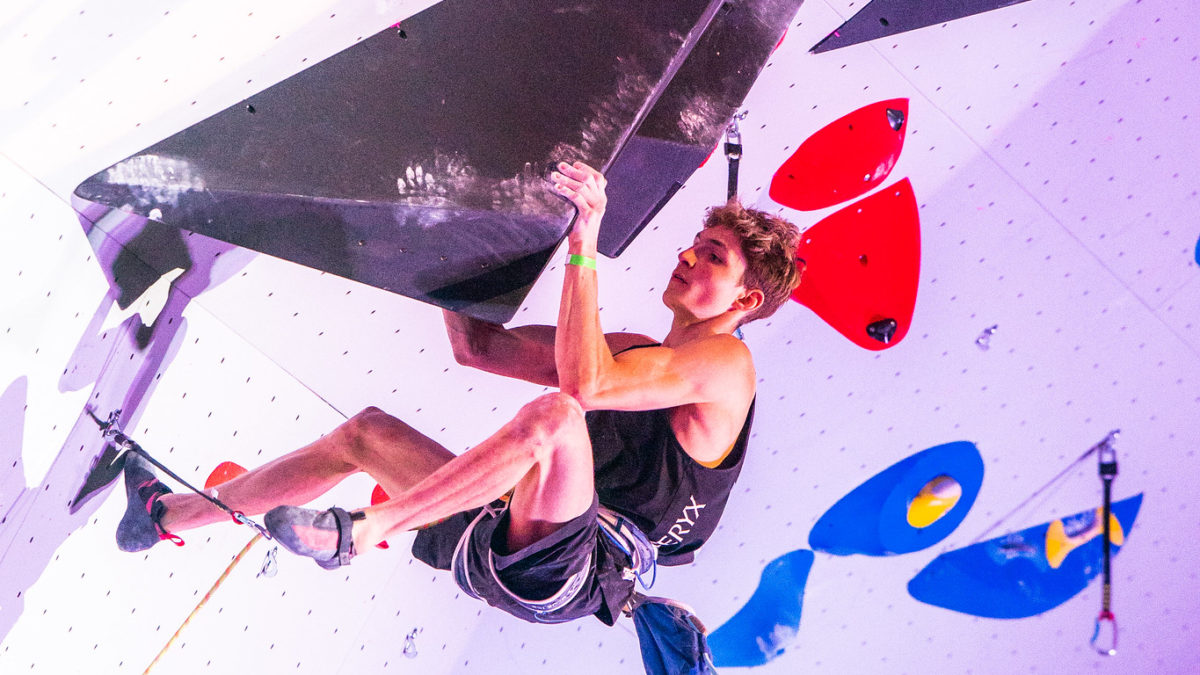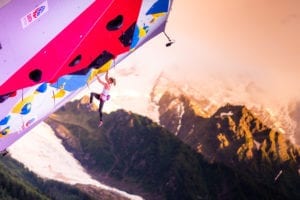Stunning Results for North Americans in Finals
North American athletes have stunning result in Chamonix Finals. Italian Laura Rogora takes in to the top.

Where the Semi-Final round left many frustrated with the separation, Finals offered a historic night for Canadian climbing. Between the perfectly separated Women’s field and the incredible performance of the North Americans, Chamonix presented itself in good style.

After an unfortunate Semi-Final filled with nine tops, eight women entered Finals unseparated by their performance. Although frustrating, it did add an element of intrigue to the event as each athlete entered the field with an opportunity to win.
Although Italian Olympian Laura Rogora would become the favourite for the round, several athletes had the capacity for a strong performance.
Team USA’s Ashima Shiraishi would become the first on route. The historically proficient climber moved well through the bottom of the route not finding any difficulty until she reached just beyond the middle crux.
Though she climbed well, Shiraishi would fall fatigued by the long and pumpy climb. The wall in Chamonix has become notorious for its length, especially within the context of the new hard-six-minute time limit. On such a long wall, an athlete can time out if they do not move quickly enough.
Japan’s Natsuki Tanii would follow Shiraishi to the field, climbing three moves beyond the American.

Rogora would follow Tanii and, keeping that pace in mind, would enter the route with speed. The Olympian would not pause in her quest to the top of the route. The typically static athlete appeared to fit the climb well, exchanging hands for heel hooks in the upper section of the route. Near the 40-move mark, a challenging clip could have fumbled the Italian, but she kept her head and moved just beyond the clip before reaching down and moving the draw to the rope. This spoke of her proficiency.
She would continue to the top of the route cementing herself as one of the two best Lead competitors in the world. This result reflected her topping of the Villars Final route two weeks ago. Although Rogora topped in Villars, Janja Garnbret would win on countbacks. As Rogora qualified in sixth position for Finals, several athletes remained on the field. Many would wonder whether her top would be matched after a Semi-Final that saw so many reach the final hold.
With that said, it also seemed as though reaching the top would not be an easy task. Rogora climbed with great precision and pace and still only reached the top with 40 seconds to go. Subsequent athletes would have to climb even faster than her if they wanted to win. Due to the fact that everyone tied in Semi-Finals, a second tie would force the rankings to become separated by time-to-top.
The athletes to follow would climb well, but all would fail to move into the final boulder problem. Slovenia’s Vita Lukan and Bulgaria’s Aleksandra Totkova would each climb high, taking fourth and third respectively. Totkova showed her strength last night and has improved well over these last two World Cups. She took sixth in Villars.

Ultimately, the anticipation built for Grossman’s attempt on the route. The American has offered consistency in spades and moved powerfully through the majority of the route. Although she appeared to have the power to Top, the final clip proved tricky. While Rogora read it well and quick, Grossman appeared to not trust the clipping position. She would take nearly 30 seconds to clip that final draw and, though she would move beyond it, became too tired to complete the route. She would conclude her competition in second position.
The Men’s Field offered an almost opposite experience to the Women’s, but on a similarly well set route. Separation occurred, although few would have guessed that the entire field would fall so low on the route.
Italy’s Marcello Bombardi opened the competition climbing into the beginning of 13 move boulder problem. Falling early, he appeared disappointed by his result. Still, his efforts would ultimately earn him sixth position.
As the first man out on the field, it appeared possible that his performance was restricted by his ability, but as the competition progressed, the difficulty of the route came into focus.
Team Canada’s Victor Baudrand was next on the line. As the first male Canadian athlete to make a Lead World Cup Finals since Sean McColl, his country already felt great pride in the 18-year-old athlete. His astounding performance in the Semi-Final would become his best yet, but the young Canadian had more to give.
Although he stumbled slightly in pulling off the ground, the athlete showed his mental fortitude climbing quickly and precisely through the remainder of his moves. Where some moved through the box sequence with great difficulty, Baudrand appeared comfortable preceding the boulder problem.
Snatching grips, Baudrand would compress his way through the powerful sequence falling on the high undercling move of the problem. Baudrand would conclude in fifth position. He not only showed his proficiency in Chamonix by taking a personal best, he showed his potential for podium in upcoming competitions.
Czech climber Martin Stranik would follow Baudrand. Stranik would stick the undercling, before moving three moves beyond it. He would take third position. Stranik’s experience had made the difficulty of the route clear.
Team USA’s Sean Bailey took the stage after Stranik. Following his Gold medal in Villars two weeks ago, Bailey had become one of the favourites to win in Chamonix. Still, Swiss climber Sascha Lehmann and Italian Stefano Ghisolfi would each have a chance at Gold as well.
Bailey took to the boulder problem well. He down climbed mid-way through to get a clip, perhaps showing the insecurity of the position. Thugging his way into a cruxy undercling, it appeared as though the American felt tired. A few moves later he would fall looking somewhat disappointed. After all, he had only made it halfway up the wall.
As Bailey had qualified for Finals low, there remained the possibility for other climbers to move beyond his high point. Ghisolfi, in terms of outdoor difficulty, climbs nearly as hard as Adam Ondra, while Sascha Lehmann offers seemingly unstoppable power. Neither athlete would be able to move beyond Bailey’s high point. Ghisolfi would ultimately take second position. Lehmann would take fourth, leaving Bailey with his second consecutive Gold medal.
With yet another lead World Cup next week, the International Circuit will remain exciting up through the Olympics. After such an exciting night, with so few Olympians present, it will become exciting to see the level of Olympic competition.
Featured Image by Daniel Gajda


